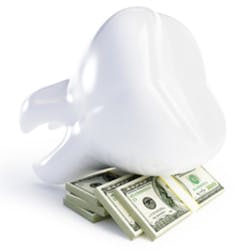Getting more into your retirement plan so one day you can get more out
Many dentists have told me since that article appeared, “I want to save the maximum amount for my retirement.” But they have not considered the federal regulations that go along with saving large amounts into their own plans.
What is your maximum contribution?
This is the first question you need to ask yourself. Of course, there are rules and regulations as to how much you can save in traditional plans and get the tax benefits from those plans. There are also rules for how dentists must contribute for their staff members.
Before even thinking about the regulations, ask yourself how much you really want to save for your retirement. What’s your budget? That number may be far below or above the federal regulation, but starting with your number gets the plan started in the right direction.
Ask yourself if tax relief is important. Do you need a tax break now? What about when your income is taxed in retirement? Do you want to set up your plan to ease that burden as well? What about your staff? Do you currently contribute to a plan on their behalf? Or do you pay them higher than average and let them use the cash how they prefer? Are you opposed to making larger contributions for them if it means a greater savings rate and tax relief for you?
Beyond answering these questions, the team at Slate, Disharoon, Parrish & Associates LLC tell our dental clients to keep these points in mind:
You’ve got to have the money
Your practice must have the cash to contribute. Sounds too obvious, but it is a point that is often missed. If you implement a 401(k) and make your own max contribution, it comes out of your paycheck. However, the matching funds increase the budget along with the rest of payroll. Also, it’s common to qualify for large profit sharing contributions, and the practice has made a profit, but the requisite cash is not in the bank. Be sure you work closely with your bookkeeper, CPA, and financial advisor to track your cash flow to make your full contributions for whatever type of plan you have.
You’ll likely be required to contribute for staff
A dentist may say,“I like the sound of contributing $52,000 to my account and $52,000 to my spouse’s account.” The dentist should like that, and it is possible. However, the type of plan that would allow this would also require an automatic 3% match to all of your full-time staff, even if they do not contribute. You would also have to share profit sharing contributions proportionate to your own.
“But wait a minute!” you say. “I want to save more for me!” Of course you do and you should. But just keep in mind that your contributions will likely ease your tax burden today, freeing up cash to contribute to your staff. Your larger contributions to their accounts will likely increase satisfaction and loyalty, and a profit sharing component requires your team to help increase profits.
Capacity + tax savings > staff contributions
This is your formula for success and the formula to determine what type of plan works for you. Capacity is how much you can get into your plan. Obviously, tax savings is the amount of tax relief you can expect to receive by contributing. Staff contributions are the matching dollars that come out of production. Your increased capacity plus your tax savings should benefit you more than the cost of staff contributions. Even if the staff contributions are a greater cost than your overall benefit, the security of knowing you are saving more for retirement is worth it.
Good retirement plan designs are similar to good treatment plans—they are individualized to each case. Your goals and desired outcomes, your budget, and your staff census all play a part in determining your best design. The best step is to provide your information to a qualified financial advisor to create a variety of scenarios for your situation, then you can be empowered to make the best choices.
For the most current practice management headlines, click here.
For the most current dental headlines, click here.
Be sure to consult with your tax advisor and a qualified financial advisor before starting a retirement plan. The information in this article is summary in nature, and each plan has nuances that must be considered before choosing the one for you and your practice.
Will Parrish is a founding partner of Slate, Disharoon, Parrish and Associates LLC in Knoxville, Tennessee. Feel free to contact Will with questions via email [email protected] or phone at (865) 357-7373. Visit their website, sdp-planning.com, or connect with Will on LinkedIn at linkedin.com/in/willparrish/.
Securities offered through Registered Representatives of Cambridge Investment Research, Inc., a Broker/Dealer, Member FINRA/SIPC. Advisory services offered through Cambridge Investment Research Advisers, Inc., a Registered Investment Advisor. Slate, Disharoon, Parrish & Associates, LLC and Cambridge are not affiliated. Cambridge does not provide tax advice.
About the Author

Will Parrish
Will Parrish is a founding partner of Slate, Disharoon, Parrish & Associates LLC in Knoxville, Tennessee. He specializes in risk management for his clients, who tend to be business owners and professionals. Will focuses on protecting his client’s interests and assets, whether under the umbrella of a comprehensive financial plan or through the use of financial products. Feel free to contact him with questions at [email protected] or (865) 357-7373. Visit sdp-planning.com or connect with him on LinkedIn.
Updated May 2, 2018


